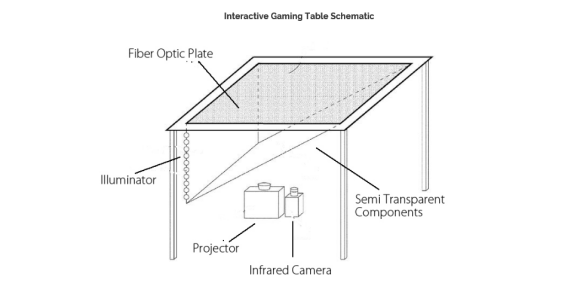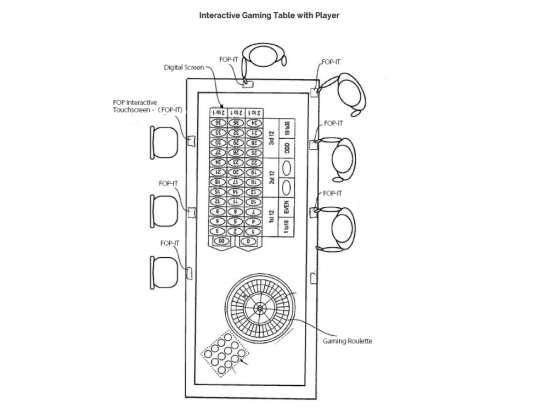Casino interactive gaming table based on Fiber Optic Plate
– DESCRIPTION
A touch screen player interface includes a fiber optic plate, high-resolution infrared camera and projector. The fiber optic plate acts as a display surface for the output of the projector as well as a fingerprint scanner. Individual fiber optic plates acting as individual player interfaces or a single fiber optic plate configured to support multiple player interfaces are conceivable. The touchscreen provides an interactive gaming system capable of identifying and authenticating players during common touch interactions. The touch screen interface may be integrated into virtual gaming systems such as virtual roulette, poker and craps systems. Live, human-managed gaming tables may also incorporate the touch screen player interface described herein.
– APPLICATION BACKGROUND
Casino gaming comes in two general forms, namely live games of chance involving a human dealer (e.g., blackjack) and electronic games of chance (e.g., slot machines). Many live games of chance are also offered in electronic form. For example, blackjack is offered as a live game of chance as well as via an electronic gaming machine configured to conduct a blackjack game. Moreover, given limited floor space, many electronic games of chance utilize a single gaming machine with multiple player interfaces to accommodate multiple players. For example, some virtual roulette gaming tables are fully automated and include multiple player stations each including a player interface configured to allow a player to cash in, place wagers and cash out.
Over the years certain innovations have become ubiquitous in the gaming industry. Player tracking is one such innovation that has changed the gaming industry. By tracking the play of players, casinos are now able to direct market to individual players based on their play. Player tracking has routinely involved the use of a player card having a magnetic data strip and a card reader configured to read the magnetic card. A central, software-based system is used to collect and maintain data from play of individual players. Normally, the data is stored in a database including individual player files.
While the aforementioned player tracking systems have worked well, it would be advantageous to develop a new system for tracking play. It would also be beneficial if the system acted as a player interface to the subject game and further authenticated player identities.
– SCHEMATIC ILLUSTRATION



